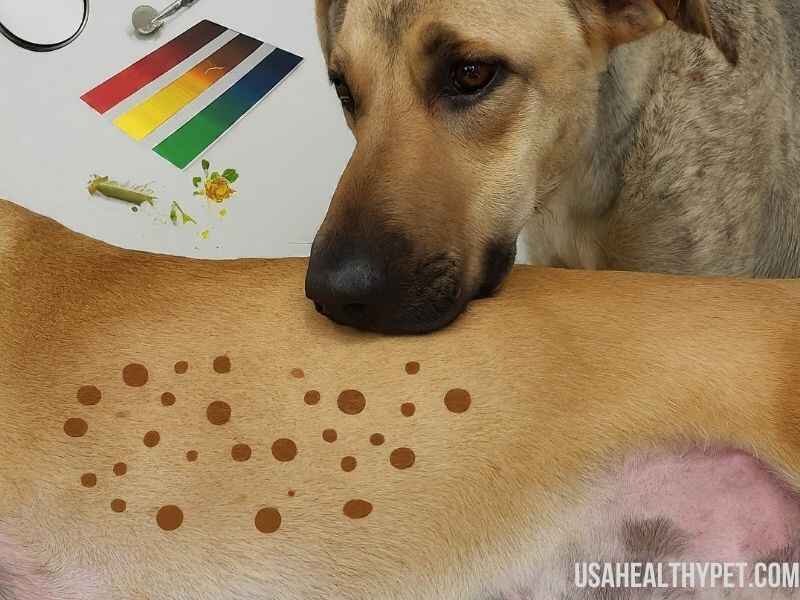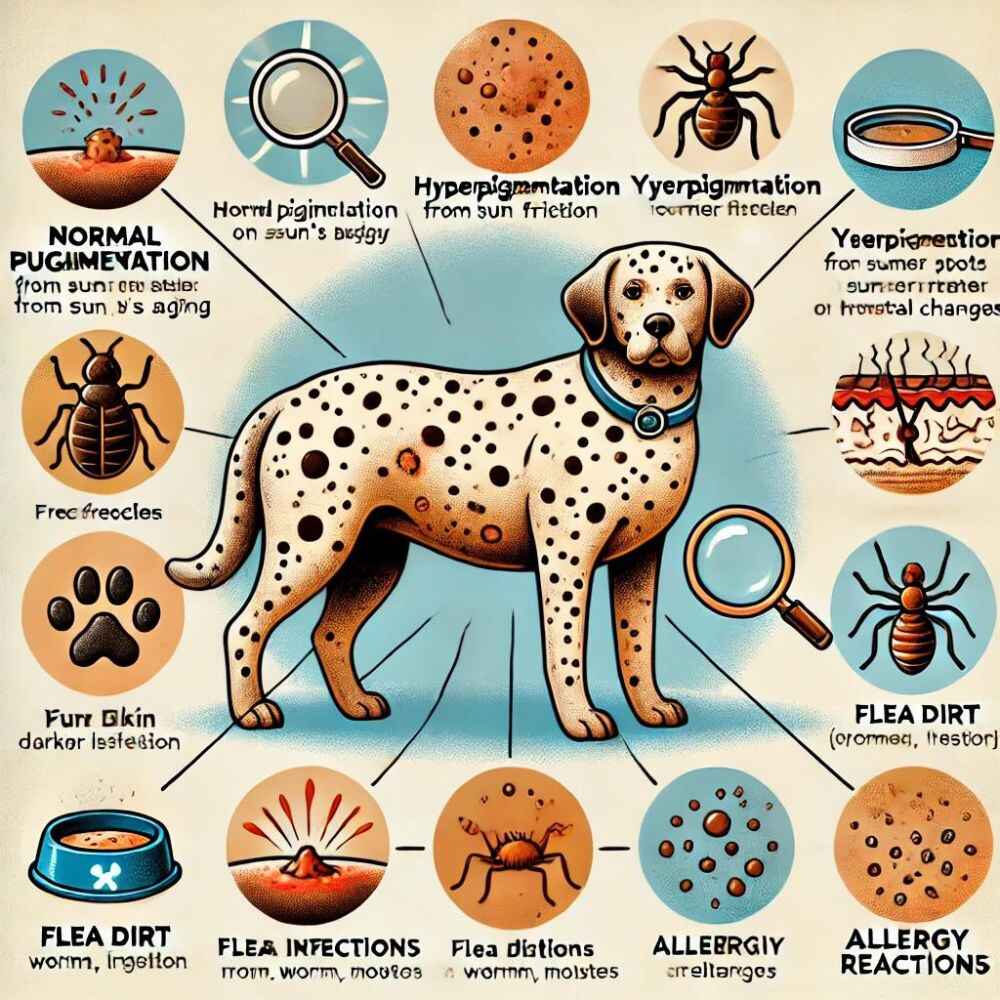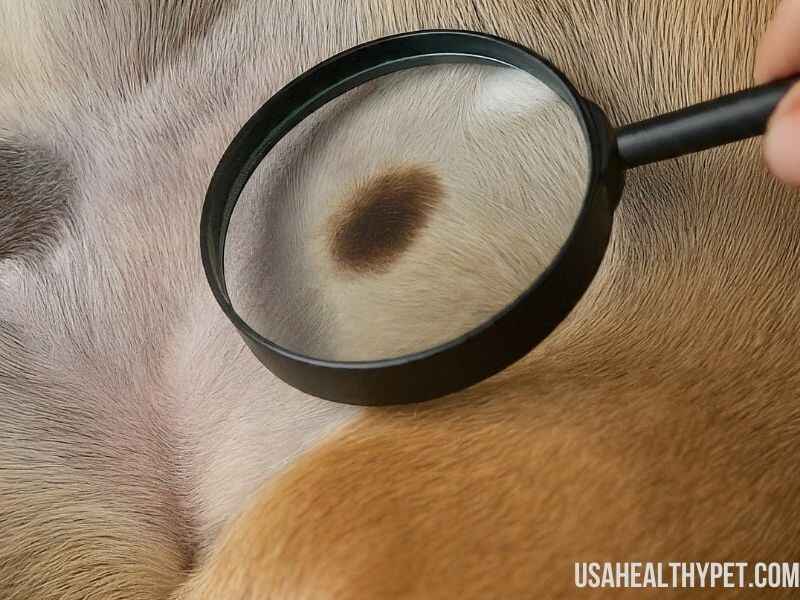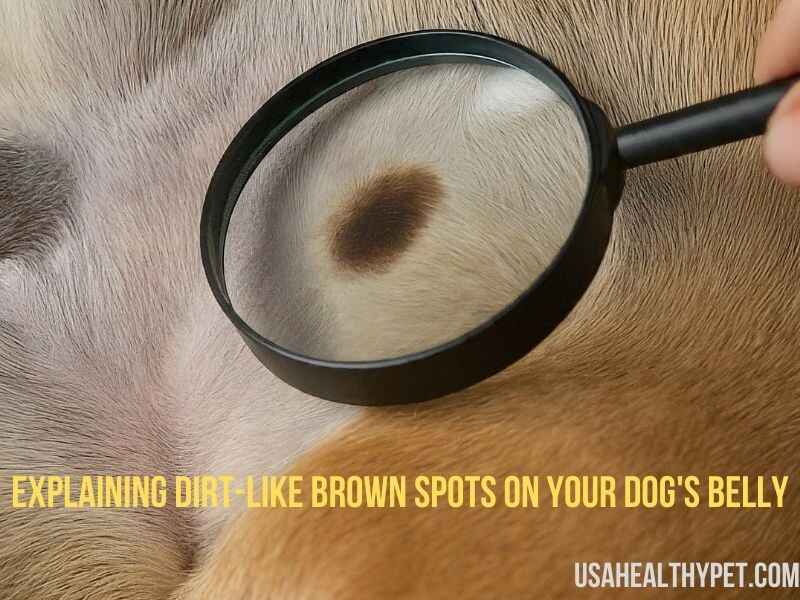So, you’ve noticed some strange, dirt-like brown spots on your dog’s belly. Maybe you’ve tried wiping them off, but they won’t budge.
There are many possible explanations for these marks, and not all of them are cause for alarm.
Let’s walk through some of the most common reasons why these spots show up and what you can do about them.
Key Points:
- Dirt-like brown spots on your dog’s belly can be caused by normal pigmentation, hyperpigmentation, infections, flea dirt, or allergies.
- Normal pigmentation changes are common and harmless, especially in older dogs.
- Yeast infections and flea dirt are common culprits for brown spots that appear suddenly or cause irritation.
- Visual inspection and simple tests (like a wet cotton ball test for flea dirt) can help identify the cause.
- When to worry: If the spots are raised, change shape, or are accompanied by itching, redness, or swelling, consult a veterinarian.
- Preventive care: Regular grooming, flea control, and a balanced diet rich in omega-3 fatty acids can help maintain healthy skin and prevent brown spots.
- Home remedies like coconut oil, apple cider vinegar (diluted), and oatmeal baths can soothe minor skin issues.
What are Dirt-Like Brown Spots on a Dog’s Belly?
Dirt-like brown spots can be anything from harmless pigment changes to signs of underlying skin issues. Sometimes, they’re just a normal part of your dog’s skin development, especially as they age.
Other times, they might indicate a condition that needs a bit of attention. Knowing what to look for can make all the difference in ensuring your pet stays healthy and happy.
Common Causes of Brown Spots on a Dog’s Belly
A. Normal Pigmentation
Did you know that dogs can develop freckles just like humans? That’s right! Normal pigmentation changes are common in dogs, especially as they grow older.
These spots can appear anywhere on the body, including the belly. They’re usually flat, harmless, and don’t change in size or shape.
B. Hyperpigmentation
Hyperpigmentation is when the skin becomes darker in certain areas. It can happen for a variety of reasons, like friction from your dog’s harness or collar, exposure to the sun, or even hormonal changes.
This type of pigmentation is generally nothing to worry about, but if it’s accompanied by other symptoms, you might want to consult a vet.

C. Yeast Infections
Yeast infections are another common culprit. If the brown spots have a reddish or irritated border, or if your dog is scratching a lot, a yeast infection might be to blame.
Yeast thrives in warm, moist environments, so areas like the belly, armpits, and between the toes are prime spots for overgrowth.
Research Insight: A 2016 study by the American College of Veterinary Dermatology found that about 60% of dogs with brown patches on their belly had an overgrowth of Malassezia yeast, a common cause of skin infections in dogs. The study highlighted that antifungal treatments were effective in reducing both the yeast and the brown discoloration within a few weeks.
D. Flea Dirt
What looks like dirt could be flea dirt—tiny specks of flea excrement. Flea dirt often resembles ground pepper and can cause skin irritation or allergic reactions.
A quick way to test for flea dirt is to wet a cotton ball and rub it over the spots. If it turns reddish-brown, you’re dealing with flea dirt.
Research Insight: A 2019 clinical study published in Veterinary Parasitology examined 120 dogs with flea infestations and found that 75% exhibited signs of flea allergy dermatitis, which includes dirt-like brown spots. The study concluded that regular flea control measures are crucial to prevent skin problems related to flea dirt.
E. Allergic Reactions
Dogs can be allergic to a range of things, from food to grass. Allergic reactions often manifest as skin issues, including brown spots.
If you notice these spots after a change in diet or a romp through a new field, allergies could be the cause.
Expert Opinion: Dr. Jean Dodds, a specialist in veterinary immunology, notes that dogs can have allergic reactions to various environmental factors. These reactions often show up as skin changes, including brown spots. She recommends observing when and where these spots appear and seeking veterinary advice if you suspect an allergy.

How to Identify the Cause of Brown Spots
A. Visual Inspection
Start with a good look. Are the spots flat or raised? Do they look like pigment or are they more like dirt? Are they clustered or spread out? Use these clues to narrow down the possibilities.
B. Smell Test
A quick sniff might help. You might be dealing with a yeast infection if there’s a yeasty or musty odor. Flea dirt, on the other hand, usually doesn’t have a strong odor.
C. Medical Tests
When in doubt, consult your vet. A skin scrape, biopsy, or blood test can help diagnose conditions like bacterial infections, autoimmune diseases, or other skin disorders.
When to Worry About Brown Spots
If you notice other symptoms like excessive itching, redness, swelling, or if the spots start changing shape or color, it’s time to visit the vet.
Persistent or worsening spots may indicate something more serious, like an infection or even skin cancer.
Home Remedies for Brown Spots on Your Dog’s Belly
- Coconut Oil: Natural and soothing, coconut oil can help with minor skin irritations and has antifungal properties.
- Apple Cider Vinegar: Diluted with water, it can act as a natural antiseptic for skin issues.
- Oatmeal Baths: A gentle oatmeal bath can soothe irritated skin and reduce itching.
Veterinary Treatments for Persistent Brown Spots
For stubborn or recurring spots, a vet might prescribe medicated shampoos, antifungal creams, or even antibiotics.
In severe cases, a biopsy might be necessary to rule out more serious conditions.
How to Prevent Brown Spots from Appearing
- Regular Bathing: Use dog-friendly shampoos to keep the skin clean.
- Flea Control: Regular flea prevention treatments can prevent flea dirt.
- Healthy Diet: Feeding your dog a balanced diet with plenty of omega-3 fatty acids can support skin health.

Importance of a Healthy Diet in Skin Care
A well-balanced diet is crucial for maintaining your dog’s overall health, including their skin.
Make sure to include high-quality proteins, healthy fats, and a range of vitamins and minerals to keep that coat shiny and skin healthy!
Research Insight: A 2017 study by the University of California, Davis School of Veterinary Medicine found that dogs on diets rich in omega-3 fatty acids, zinc, and vitamins E and C had fewer instances of skin discoloration and other dermatological issues. The study suggests that diet plays a significant role in maintaining skin health.
Skin Care Products for Dogs: Do They Work?
Many products promise to make your dog’s skin flawless, but do they work? Look for products with natural ingredients and avoid harsh chemicals that could irritate the skin.
The Role of Regular Grooming in Skin Health
Regular grooming is more than just making your dog look good; it’s essential for detecting any changes in your dog’s skin early on. Plus, it helps distribute natural oils that keep their skin hydrated.
Allergies and Your Dog’s Skin: What You Need to Know
Just like us, dogs can have allergies. Watch for changes in skin color, texture, or hair loss. If your dog is licking, scratching, or chewing their skin, it could be an allergic reaction.
Can Brown Spots Be a Sign of Something Serious?
In rare cases, brown spots can indicate serious conditions like Cushing’s disease or even cancer. Always monitor any changes and consult your vet if you’re concerned.
Expert Opinion: Dr. Lisa M. Freeman, a veterinary nutritionist, warns that while brown spots are often harmless, they can sometimes indicate more serious health conditions. She stresses the importance of regular veterinary check-ups to catch any potential problems early.
Research Studies and Expert Opinions on Brown Spots
Recent research and expert opinions indicate that brown spots on a dog’s belly can be caused by a variety of factors.
Studies have shown that yeast infections, flea dirt, and allergies are among the most common causes, and experts like Dr. Jean Dodds and Dr. Lisa Freeman emphasize the importance of regular veterinary care and preventive measures to maintain your dog’s skin health.
Common Myths About Brown Spots on Dogs
- “All brown spots mean cancer.” – False! Many spots are harmless pigmentation or minor skin issues.
- “Flea dirt only appears on dogs with fleas.” – Not necessarily; even a few fleas can cause dirt.
Conclusion
Seeing dirt-like brown spots on your dog’s belly can be concerning, but remember, they’re usually harmless. The key is to stay observant and proactive in identifying any changes.
Regular grooming, a balanced diet, and a healthy lifestyle can go a long way in preventing and treating skin issues. If you’re ever in doubt, a quick visit to the vet can provide peace of mind.
FAQs
- Can dirt-like brown spots be washed away?
Not always. Some spots are pigment changes and won’t wash off, while others, like flea dirt, may come off with a bath. - Are these spots painful for my dog?
Typically, no. However, if they are scratching or seem uncomfortable, it could indicate irritation or infection. - Can I use human skin care products on my dog?
No, human skin care products can be too harsh for a dog’s sensitive skin. - How do I know if the brown spots are serious?
If the spots change shape, size, color, or are accompanied by other symptoms, consult your vet. - Can diet affect my dog’s skin health?
Absolutely! A balanced diet rich in omega-3 fatty acids can help maintain healthy skin and coat.

Pingback: Can Bulldogs Have Down Syndrome? Understanding the Facts
Pingback: How Long Does K9 Advantix Take to Work?
Pingback: What Oil Is Good for Dogs with Itchy Skin? Natural Solutions